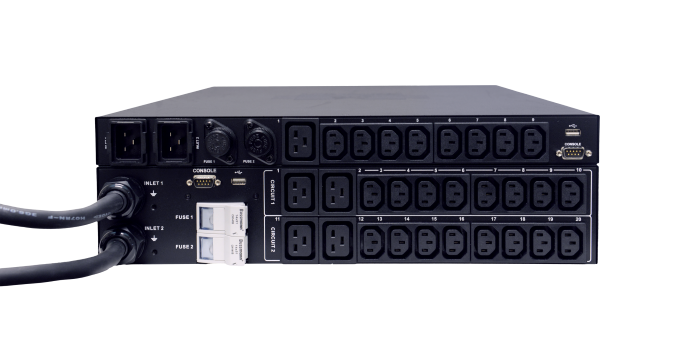The Raritan Blog
Home » Raritan Blog » Understanding Overload Protection in Raritan’s Rack Transfer Switch
Understanding Overload Protection in Raritan’s Rack Transfer Switch
David Wood
February 16, 2016

This past week, we opened our mailbag and found the following customer email:
Dear Raritan team,
We mostly love the 16A rated rack transfer switch so far! The physical design made it easy to connect power feeds from the back of the cabinet. The outlet-level metering and switching let us power off development servers no one was using on weeknights and weekends. But, here’s one thing that wasn’t so great:
We recently experienced a total device failure. We weren’t sure what it was at first, but quickly realized it was a blown fuse from both the web interface and indicator lamp/alarm on the unit. Once we replaced the fuse the unit continued operating just fine. But, why is it there in the first place? And why not have a circuit breaker instead of a fuse?
Tl;dr What is the purpose of the fuses located on the inlet side of Raritan’s rack transfer switch and why not have a circuit breaker instead?
Those are great questions. So first, let’s address the question of why the fuse is there in the first place. The purpose of the fuse (rated at 32A) in the 16A rated transfer switch is to protect the switching circuitry in case of an IT device power supply failure that results in a short circuit (fast, high current spike). This particular type of fuse is what’s called a fast-blow fuse. It is commonly used in electrical equipment where an overload current can damage sensitive circuitry.
But, don’t confuse this with normal circuit overcurrent protection which is already provided by the facility’s circuit breaker. For example, if you were to load the transfer switch and exceed 16A, the facility’s breaker would trip but the fast-blow fuse would remain intact.
On the other hand, if say, the server plugged into outlet number one on the transfer switch were to experience a power supply failure (resulting in a short circuit and high current load spike), the fast-blow fuse on the inlet side would quickly melt and break to protect the rest of the unit from being damaged or even going up in flames!
Now, on to the second question: why fuses are used for overload protection instead of circuit breakers. Fuses are used in place of circuit breakers for two specific reasons. The first reason is that fuses have a more exact tripping point and faster response time than most circuit breakers.
The second reason is that most circuit breakers are designed to trip a finite amount of time. And, although it’s easier to reset a breaker than it is to replace a fuse, once the breaker needs to be replaced, there’d be no way to do it out in the field because the breaker would be soldered onto the switch.
So any way that you slice it, you’re better off paying $15 for a pack of two dozen fast-blow fuses, than you would be if you had to replace the entire transfer switch or ship it back to Raritan for repairs.
Other transfer switch solutions in the market today do not offer field serviceable fuse protection. So, when the IT device power supply fails and a short circuit occurs, the device switching circuitry will also fail and the entire unit will need to be ripped out of the rack and replaced.
Side note: For our 30/32A transfer switch configurations, the unit has both fuses and circuit breakers. The circuit breakers are required to protect the branch circuits in the same way they are used on a rack PDU (required for any PDU greater than 20A rated). The fuse is rated higher than the facility circuit breaker so it can protect the switching circuitry from high current spikes caused by IT device power supply failure.
Learn more about what sets Raritan’s rack transfer switch apart, or contact our sales department for a no-strings-attached price quote.
Other Blog Posts
- The Rapid Growth of AI and the Use of Raritan PDUs to Meet Higher Power Demands
- Posted on October 11, 2023
- Data Center Report Fewer Outages, But Downtime Still Costly
- Posted on September 20, 2023
- Survey: Energy Usage and Staffing Shortages Challenge Data Centers
- Posted on September 20, 2023
- Raritan Secure Switch: Secure NIAP 4.0 Compliant Desktop KVM
- Posted on September 20, 2023
- The Midwest is a Hot Market for Data Centers: How the New Generation of Intelligent Rack PDUs Can Save Cloud Giants Uptime and Money
- Posted on September 7, 2023
Subscribe
Upcoming Events
- Advancing Data Center Construction West 2024
- May 6 – 8 • Salt Lake City, UT
- Net Zero Data Center
- May 16 – 17 • Dallas, TX
- 7x24 Exchange Spring
- June 9th • JW Marriott Orlando Grande Lakes
Latest Raritan News
- Legrand Certifications and Process Controls Provide Confidence in Information Security for Network-Connected Devices in Data-Related Applications
- Posted on April 1, 2024
- Legrand Releases Version 4.0 of Raritan’s Industry-Leading Secure KVM Switches, Raising Bar for Secure Desktop Access
- Posted on July 31, 2023
- Legrand Revitalizes Data Center Sector with Two Revolutionary Intelligent Rack PDUs
- Posted on May 1, 2023
- Raritan Reveals The MasterConsole® Digital Dual KVM Switch
- Posted on February 18, 2021
- Legrand Data, Power and Control Division Announced as Finalist in Six Categories at DCS Awards 2020
- Posted on November 9, 2020